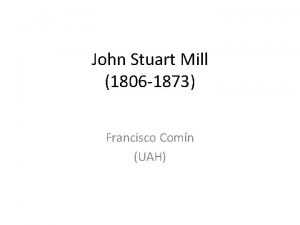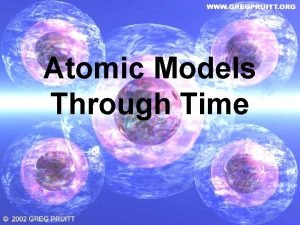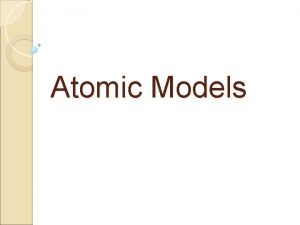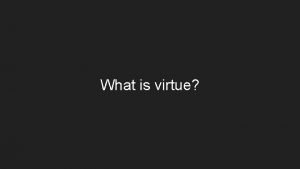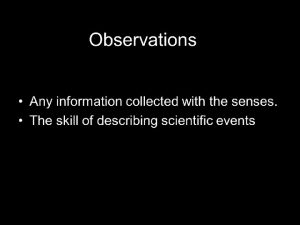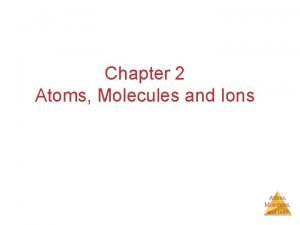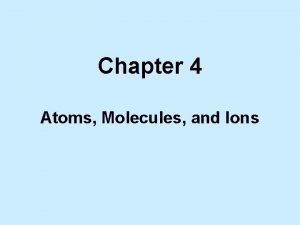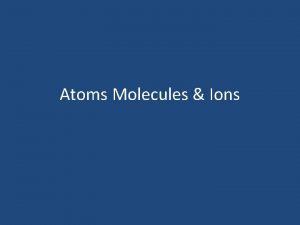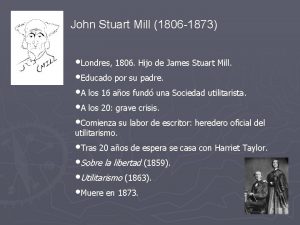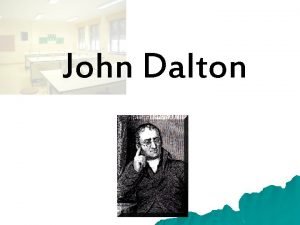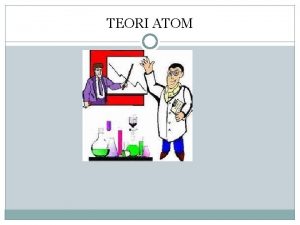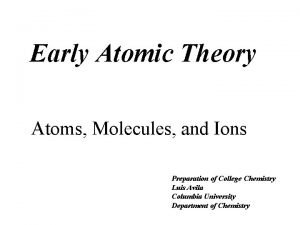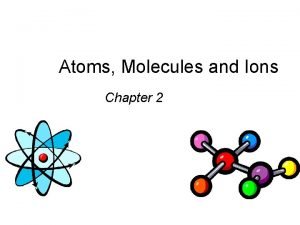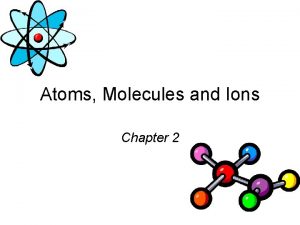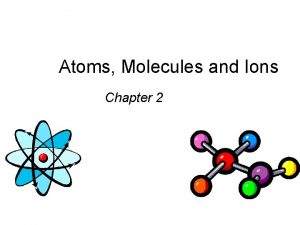Atoms Molecules and Ions John Dalton 1806 Atomic















- Slides: 15

Atoms, Molecules and Ions John Dalton 1806 Atomic Theory of Matter 1. Matter consists of indivisible atoms 2. All atoms of a given element have identical properties 3. Different elements have atoms that differ in mass 4. Atoms are indestructible and chemical reactions are a rearrangement of atoms 5. Compounds contain a definite and small number of atoms

1. Matter consists of indivisible atoms subatomic particles electrons protons neutrons 1. electrons 2. protons 3. neutrons charge = -1. 60 x 10 -19 C = -1 mass = 9. 1 x 10 -31 kg charge = +1 mass = 1. 673 x 10 -27 kg charge = 0 mass = 1. 675 x 10 -27 kg

1. Matter consists of indivisible atoms nucleus = protons + neutrons electrons move around the nucleus electron “cloud” = volume of atom average diameter of atom 10 -10 m = ångström (Å)

2. All atoms of a given element have identical properties ? not exactly A ZX atoms of an element = same number of protons atomic number = Z Z = 6 = C carbon Z = 30 = Zn zinc 6 C 30 Zn 6 e 30 e- elements neutral # protons = # eelements different # neutrons proton + neutron = A = mass number

2. All atoms of a given element have identical properties element can have isotopes carbon Z = 6 most abundant 6 neutrons Carbon-14 dating 6 protons + 8 neutrons A ZX 7 nuclides of C 12 C 6 14 C 6 What is the symbol for a nuclide that contains 22 neutrons and 18 protons? 40 18 Ar

4. Atoms are indestructible and chemical reactions are a rearrangement of atoms reactions valence electrons valence e- = Group number 1 2 8 3 4 5 6 7

1 2 8 3 4 5 6 7 elements arranged by atomic number column group chemical properties row period

Noble gases unreactive 8 valence electrons (He 2 valence e-) monatomic gases Alkali metals soft solids very, very reactive 1 valence electron lose 1 electron + Na ( 11 protons, 10 e-) Na (11 protons, 11 e ) cation

Alkaline earth metals solids reactive lose 2 electrons 2 valence electrons Sr Sr 2+ conduct heat, electricity solids (Hg) lose enon-metals

Non-metals 3 B 5 4 5 6 7 C 6 N 7 O Si 14 P 15 S 16 Cl 17 As 33 Se 34 Br 35 Te 52 I 53 poor conductors solids, liquids, gases 8 F 9 = metalloids At 85 Group 7 halogens X 2 very reactive 7 valence electrons gain 1 electron Cl (17 protons, 17 e-) Cl - (17 protons, 18 e-) anion non-metals gain electrons

H 1 doesn’t fit anywhere lose e+ H (1 proton, 0 e-) H (1 proton, 1 e ) gain eproton H (1 proton, 2 e-) H (1 proton, 1 e ) hydride

5. Compounds contain a definite and small number of atoms Ionic solids cation + anion + metal non-metal sodium + chlorine Na. Cl sodium chloride Na+ Cl o. C 801 lithium + oxygen 2 Li 2 O lithium oxide Li + O o. C > 1700 magnesium + nitrogen Mg 2+ N 3 - Mg 3 N 2 magnesium nitride strong interactions (ion-ion) high melting points

Transition metals more than 1 form except aluminum+ sulfur Al 3+ S 2 Al 2 S 3 aluminum sulfide Ag+ Zn 2+ manganese + oxygen Cd 2+ Mn 1+ Mn 2+ Mn 3+ Mn 4+ Al 3+ 23+ 4+ 2 Mn Mn 22 O 3 O Mn Mn. O O manganese(IV) manganese(III)oxide

Covalent compounds non-metal + non-metal share valence electrons = chemical bonds carbon + chlorine 1 mono 4+ Cl C 2 di 3 tri CCl 4 4 tetra carbon tetrachloride 5 penta nitrogen + oxygen ? N O 2 NO nitrogen monoxide 2+ 4+ NO 2 nitrogen dioxide N 2 O 4 dinitrogen tetroxide 4+ 6 hexa 7 hepta 8 octa

N 3+ H 1 - Covalent compounds NH 3 nitrogen trihydride H 1+ O 2 - H 2 O dihydrogen monoxide ammonia water weak forces low m. p. 0. 0 o. C Table 2. 5 p. 62 Polyatomic ions NH 4+ OHNO 3 SO 42 PO 43 - ammonium hydroxide nitrate sulfate phosphate Cl. O 3 Mn. O 4 Cr. O 42 CO 32 - chlorate permanganate chromate carbonate
 Ion chapter 11
Ion chapter 11 Atoms molecules and ions
Atoms molecules and ions Atoms molecules and ions
Atoms molecules and ions Atoms molecules and ions
Atoms molecules and ions Atoms ions and molecules
Atoms ions and molecules Atoms ions and molecules
Atoms ions and molecules States that atoms ions and molecules must collide to react
States that atoms ions and molecules must collide to react Chapter 2 atoms molecules and ions
Chapter 2 atoms molecules and ions John stuart mill (1806-1873)
John stuart mill (1806-1873) John dalton's atomic model
John dalton's atomic model Atomic model timeline
Atomic model timeline John dalton atomic theory
John dalton atomic theory John dalton atomic model drawing
John dalton atomic model drawing What do the roman numerals in a cation's name indicate?
What do the roman numerals in a cation's name indicate? It is a habitual and firm disposition to do good
It is a habitual and firm disposition to do good Forensic science meaning
Forensic science meaning








